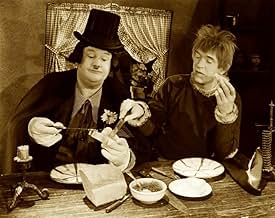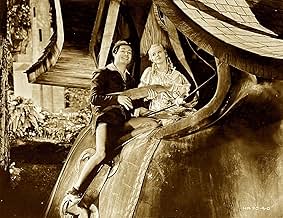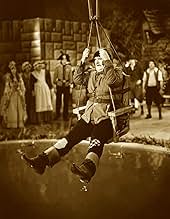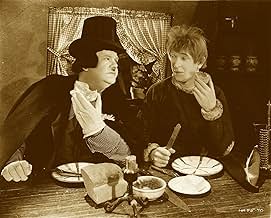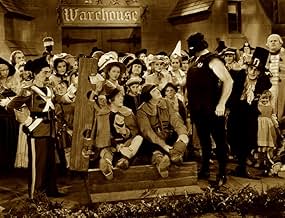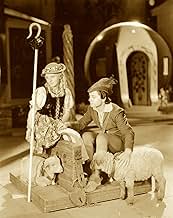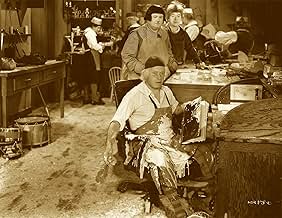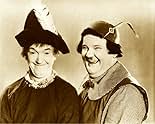VALUTAZIONE IMDb
7,1/10
7943
LA TUA VALUTAZIONE
Opponendosi al malvagio Barnaby, Ollie Dee e Stanley Dum cercano di ripagare il mutuo di Madre Peep.Opponendosi al malvagio Barnaby, Ollie Dee e Stanley Dum cercano di ripagare il mutuo di Madre Peep.Opponendosi al malvagio Barnaby, Ollie Dee e Stanley Dum cercano di ripagare il mutuo di Madre Peep.
- Regia
- Sceneggiatura
- Star
- Premi
- 1 vittoria in totale
Henry Brandon
- Silas Barnaby
- (as Henry Kleinbach)
Ernie Alexander
- Townsman
- (non citato nei titoli originali)
Richard Alexander
- King's Guard
- (non citato nei titoli originali)
Frank Austin
- Justice of the Peace
- (non citato nei titoli originali)
Florine Baile
- Girl
- (non citato nei titoli originali)
Eddie Baker
- Dunker
- (non citato nei titoli originali)
Scotty Beckett
- Schoolboy
- (non citato nei titoli originali)
Georgie Billings
- Schoolboy
- (non citato nei titoli originali)
Charles Bimbo
- Jack in the Box
- (non citato nei titoli originali)
Billy Bletcher
- Chief of Police
- (non citato nei titoli originali)
Eddie Borden
- Demon Bogeyman
- (non citato nei titoli originali)
Carl R. Botefuhr
- Schoolboy
- (non citato nei titoli originali)
Recensioni in evidenza
When video was much less accessible, I waited every holiday season to see this movie. I always remembered the fun stuff, especially Laurel and Hardy, but forgot some of the bad music and rather draggy dialogue. Nevertheless, the set designers did a nice job creating this nursery rhyme world, with three little pigs (one of whom gets turned to sausages), and a raft of other characters. The scenes in the toy shop with the Boys are the best. I do remember as a small child being pretty terrified of that land of the bogy men. It was well done, as are all places where "you must never go" or "where you will be banished to." Stan and Ollie do their shtick with finger wiggles and some silly game called "peewees." They attempt to save the day for the old woman who lives in a shoe. They manage to bumble everything up royally. Still, as things play out, this doesn't have the tightly knit fabric of their best comedies--they need to be on camera more. But as a holiday event, this is worth a look for a new generation.
BABES IN TOYLAND (Hal Roach/MGM, 1934), directed Gus Meins and Charles Rogers, is a musical fairy tale based on Victor Herbert's 1903 operetta that became tailor-made for the talents of comedy team Stan Laurel and Oliver Hardy in what's considered to be their very best and highly acclaimed adaptation taken from an operatic work, thanks to its fine script, comedy material and notable storybook characters brought to life on the screen. In spite of Stan and Ollie having to take time away from the screen in favor of plot development, musical interludes and romantic subplot, even appearing nearly ten minutes from the start of the story, the movie, overall, succeeds.
Set in the mythical land of Toyland, Widow Peep (Florence Roberts) is an old woman about to be evicted from her home by the evil Silas Barnaby (Henry Brandon) unless her mortgage is paid. Barnaby is willing to overlook the matter and offer her the deed in favor of being honored for having her daughter, Bo-Peep (Charlotte Henry) as his bride. Bo-Peep loves Tom Tom Piper (Felix Knight, dressed like Peter Pan), and will have nothing to do with him. Stanley Dumb (Stan Laurel) and Oliver Dee (Oliver Hardy), a couple of toy-makers who take up room and board in Widow Peep's home, attempt to help by asking their employer, the toy master (William Burress) for an advance in salary, but because Stanley confused Santa Claus's (Ferdinand Munier) order 600 toy soldiers at one foot high, thus giving him 100 toy soldiers at six foot high instead of 600 soldiers at 1 foot high, they both get fired, and must come up with another solution in rescuing Bo-Peep from the clutches of Barnaby.
A memorable score by Victor Herbert, only a few were selected for the screen, including: "Toyland" (sung by Virginia Karns); "Don't Cry, Bo-Peep, Don't Cry" (sung by Felix Knight); "The Castles in Spain," "Go to Sleep, Slumber Deep" and "The March of the Toys (Wooden Soldiers)." Some reissue prints retitled MARCH OF THE WOODEN SOLDIERS eliminate Mother Goose's opening of "Toyland" as she opens the "Babes in Toyland" storybook and introduces it main characters in song: Little Bo Peep who lost her sheep; Tom Tom the Piper's Son; The Little Old Lady Who Lived in a Shoe (Widow Peep); Silas Barnaby, "the meanest man in town"; Hi Diddle Diddle, The Cat and the Fiddle; Three Little Pigs: Elmer, Willie and Jiggs; and finally Stanley Dumb and Oliver Dee, "they love to sleep as you can see;" along with the "Go to Sleep" number, having recently been restored on both video and DVD distributions ranging from colorized to original black and white photography. The musical interludes are not overdone yet capture the mood of the story. In fact, more than half of Victor Herbert's original score has been cast aside in keeping the story to average length (79 minutes).
Charlotte Henry, who starred in Paramount's fantasy to Lewis Carroll's now forgotten screen adaptation of ALICE IN WONDERLAND (Paramount, 1933), is ideally cast as Bo-Peep. Had fate taken a different turn, one wonders if Henry would have succeeded playing Dorothy in THE WIZARD OF OZ had the L. Frank Baum story been brought to the screen about this time instead of 1939? It so happens that TOYLAND and OZ are similar in nature. They are both set in a mythical land; Silas Barnaby and the Wicked Witch are evil individuals who bring fear to those around them; Barnaby is assisted by hideous Bogeymen while the Witch has her flying monkeys; Laurel and Hardy are do-gooders similar to the Tin Man and the Scarecrow; and finally Toyland citizens bursting into song. Unlike most fantasies of this sort, BABES IN TOYLAND is not one extended dream sequence from which the leading character awakens back to reality as did Dorothy at her farm in Kansas following her Technicolor experience in the land of OZ. This is Toyland from start to finish, with a touch of Disneyland as one of the citizens of Toyland looking very much like Mickey Mouse!
While as Dee and Dumb, Laurel and Hardy perform their roles in their usual traditional manner, but minus their trademark derbys. Their key scenes include having them sneaking into Barnaby's home to retrieve Widow Peep's deed only to get caught, thanks to Stanley, and being sentenced to public dunking in a pond of cold water (only Ollie gets the treatment) and thrown out of Toyland into Boogeyland forever (the same fate later set for Tom-Tom accused of pig-napping Elmer, thanks to Barnaby); their participation in Barnaby's wedding, as well as the grand finale where the toy soldiers are brought to life from the toy factory in their war against the bogeymen with Stan and Ollie's ammunition of darts fired from the cannon. Great march formation and still photography outdoes any computer technology today since more effort was put into this sequence alone. Cartoon violence is the essence here, especially when Ollie falls victim to it in the Wile E. Coyote tradition, but not to the extreme.
More Laurel and Hardy than Victor Herbert, BABES IN TOYLAND is geared for children and adults alike, especially adults who watched this annually on television during the Christmas when they were kids themselves since the 1950s. In recent years, TOYLAND aired on American Movie Classics (1994-1996) and finally Turner Classic Movies (TCM premiere: December 24, 2012, with original theatrical title intact). Remade theatrically in 1961 by Walt Disney Productions, then again as either television movies or new theatrical adaptations in later years, it's the 1934 original that appears to live on happily ever after. (***1/2)
Set in the mythical land of Toyland, Widow Peep (Florence Roberts) is an old woman about to be evicted from her home by the evil Silas Barnaby (Henry Brandon) unless her mortgage is paid. Barnaby is willing to overlook the matter and offer her the deed in favor of being honored for having her daughter, Bo-Peep (Charlotte Henry) as his bride. Bo-Peep loves Tom Tom Piper (Felix Knight, dressed like Peter Pan), and will have nothing to do with him. Stanley Dumb (Stan Laurel) and Oliver Dee (Oliver Hardy), a couple of toy-makers who take up room and board in Widow Peep's home, attempt to help by asking their employer, the toy master (William Burress) for an advance in salary, but because Stanley confused Santa Claus's (Ferdinand Munier) order 600 toy soldiers at one foot high, thus giving him 100 toy soldiers at six foot high instead of 600 soldiers at 1 foot high, they both get fired, and must come up with another solution in rescuing Bo-Peep from the clutches of Barnaby.
A memorable score by Victor Herbert, only a few were selected for the screen, including: "Toyland" (sung by Virginia Karns); "Don't Cry, Bo-Peep, Don't Cry" (sung by Felix Knight); "The Castles in Spain," "Go to Sleep, Slumber Deep" and "The March of the Toys (Wooden Soldiers)." Some reissue prints retitled MARCH OF THE WOODEN SOLDIERS eliminate Mother Goose's opening of "Toyland" as she opens the "Babes in Toyland" storybook and introduces it main characters in song: Little Bo Peep who lost her sheep; Tom Tom the Piper's Son; The Little Old Lady Who Lived in a Shoe (Widow Peep); Silas Barnaby, "the meanest man in town"; Hi Diddle Diddle, The Cat and the Fiddle; Three Little Pigs: Elmer, Willie and Jiggs; and finally Stanley Dumb and Oliver Dee, "they love to sleep as you can see;" along with the "Go to Sleep" number, having recently been restored on both video and DVD distributions ranging from colorized to original black and white photography. The musical interludes are not overdone yet capture the mood of the story. In fact, more than half of Victor Herbert's original score has been cast aside in keeping the story to average length (79 minutes).
Charlotte Henry, who starred in Paramount's fantasy to Lewis Carroll's now forgotten screen adaptation of ALICE IN WONDERLAND (Paramount, 1933), is ideally cast as Bo-Peep. Had fate taken a different turn, one wonders if Henry would have succeeded playing Dorothy in THE WIZARD OF OZ had the L. Frank Baum story been brought to the screen about this time instead of 1939? It so happens that TOYLAND and OZ are similar in nature. They are both set in a mythical land; Silas Barnaby and the Wicked Witch are evil individuals who bring fear to those around them; Barnaby is assisted by hideous Bogeymen while the Witch has her flying monkeys; Laurel and Hardy are do-gooders similar to the Tin Man and the Scarecrow; and finally Toyland citizens bursting into song. Unlike most fantasies of this sort, BABES IN TOYLAND is not one extended dream sequence from which the leading character awakens back to reality as did Dorothy at her farm in Kansas following her Technicolor experience in the land of OZ. This is Toyland from start to finish, with a touch of Disneyland as one of the citizens of Toyland looking very much like Mickey Mouse!
While as Dee and Dumb, Laurel and Hardy perform their roles in their usual traditional manner, but minus their trademark derbys. Their key scenes include having them sneaking into Barnaby's home to retrieve Widow Peep's deed only to get caught, thanks to Stanley, and being sentenced to public dunking in a pond of cold water (only Ollie gets the treatment) and thrown out of Toyland into Boogeyland forever (the same fate later set for Tom-Tom accused of pig-napping Elmer, thanks to Barnaby); their participation in Barnaby's wedding, as well as the grand finale where the toy soldiers are brought to life from the toy factory in their war against the bogeymen with Stan and Ollie's ammunition of darts fired from the cannon. Great march formation and still photography outdoes any computer technology today since more effort was put into this sequence alone. Cartoon violence is the essence here, especially when Ollie falls victim to it in the Wile E. Coyote tradition, but not to the extreme.
More Laurel and Hardy than Victor Herbert, BABES IN TOYLAND is geared for children and adults alike, especially adults who watched this annually on television during the Christmas when they were kids themselves since the 1950s. In recent years, TOYLAND aired on American Movie Classics (1994-1996) and finally Turner Classic Movies (TCM premiere: December 24, 2012, with original theatrical title intact). Remade theatrically in 1961 by Walt Disney Productions, then again as either television movies or new theatrical adaptations in later years, it's the 1934 original that appears to live on happily ever after. (***1/2)
I am a huge Laurel and Hardy fan, and while this may not be considered one of their great feature length films, I love to get this out for the December holidays. After the rest of the family watches "Wonderful Life", "Scrooge" and the Nutcracker, I pull this out and laugh until I cry. The only link to the holiday is the use of the "March of the Soldiers" music - but that's enough for me. Stan Laurel's ingenious battle tactics just send me into a fit.
I know this movie better as "March of The Wooden Soldiers," but it really is one of, if not the, best of Laurel and Hardy. Somehow cast as a Christmas movie (there is an arbitrary reference to Christmas in this movie, and a Santa Claus toy order is messed up), the movie shines as all of the characters in the Mother Goose tales come to life, as do the goblin-like bogey-men, but the movie's best parts shine on Laurel and Hardy's scenes. Beautiful Charlotte Henry ( fittingly enough,a former Alice in Wonderland )and Felix Knight share the rest of the movie charmingly without taking away from the duo. The songs aren't that bad either, but a special note should go to Henry Kleinbach (nee Brandon) in his portrayal as Barnaby. Plucked off the stage while doing a nearly identical role, this young actor at the time creates a more despicable role than Ray Bolger in the Disney version. In fact, Brandon lived much of his career trying to forget this role in which he was almost typecast. This is one movie that should be seen every Christmas.
10Jweybrew
Babes in Toyland was the first movie I saw on a big screen- -a holiday presentation in my grammar school auditorium, circa 1957- -uncut, unlike the many subsequent presentations I saw on TV in after years. I fell in love with Stan and Ollie, with Toyland, with the magic of the movies, all at once- -all of us watching laughed and thrilled to see all of the characters we had heard of in nursery rhymes come to life- -even the Three Little Pigs (with "Who's Afraid of the Big Bad Wolf" on the soundtrack, courtesy of Uncle Walt Disney's studio!)- -we trembled with ecstatic terror at Silas Barnaby and his army of Bogeymen and cheered the house down when Stan and Ollie discovered the Perfect way to rout them and save the day!- -and yes, many of us, watching Charlotte Henry and Felix Knight as Bo-Peep and her plucky suitor Tom-Tom (the Piper's Son), found awakening within ourselves the realization of what romantic love might be about.- -and Stan and Ollie?- -a funny, wonderful duo, children like ourselves, joyously silly and giddily amazing. I dreamt of Toyland that night, and many nights after- -sweet dreams, scarey dreams, dreams of Ollie and Stannie as wonderful friends- -and once I woke crying, realizing that once I was grown up, Toyland would fade to a distant memory. Well, I was wrong. You can go back to Toyland, that Childhood's Dreamland, any time you watch this movie. I love it. You may, too. Note: current video versions are mostly also uncut, some are colorized, which in this instance (perhaps the only one)improves the presentation!
Lo sapevi?
- QuizThe stop-motion animation for the "March of the Wooden Soldiers" scene was created by special-effects director Roy Seawright and cinematographer Art Lloyd. They used 100 wooden toy soldiers, each standing one-foot high, which had to be meticulously posed and shot frame by frame. Eleven of the toy soldiers seen in this sequence are known to survive: one drummer, one trumpeter, and nine riflemen. A Roach studio executive saved 10 of these figures and passed them down to his family, who publicly revealed their existence in 2020; that same year they sold one at auction for $14,520. Another toy soldier is owned by Laurel & Hardy historian Randy Skretvedt, who occasionally loans it out for museum exhibits.
- BlooperThe wooden soldier, brought out as a demonstration model by Stannie and Ollie, blinks in one shot.
- Citazioni
Ollie Dee: Well, Good-bye and good luck.
Stannie Dum: What do you mean, good-bye? I'm not going with you?
Ollie Dee: Why, no. You have to stay here with Barnaby. You're married to him.
Stannie Dum: [starting to cry] I don't want to stay here with him.
Ollie Dee: Why?
Stannie Dum: I don't love him.
[blubbers]
- Curiosità sui creditiThe titles appear on a child's toy building block that falls into position onscreen.
- Versioni alternativeSome prints omit the opening verses of the song "Toyland" ("When you've grown up, my dears", etc.), and begin the song with the main chorus ("Toyland, Toyland," etc.). Other prints omit Mother Goose's vocal of the song entirely, and have only the chorus singing the song.
- ConnessioniEdited into Dick und Doof - Superschau des Lachens (1966)
- Colonne sonoreToyland
(1903) (uncredited)
Music by Victor Herbert
Lyrics by Glen MacDonough
Played during the opening credits
Sung by Virginia Karns and Chorus
I più visti
Accedi per valutare e creare un elenco di titoli salvati per ottenere consigli personalizzati
Dettagli
- Data di uscita
- Paese di origine
- Lingua
- Celebre anche come
- Había una vez dos héroes
- Luoghi delle riprese
- Azienda produttrice
- Vedi altri crediti dell’azienda su IMDbPro
- Tempo di esecuzione1 ora 17 minuti
- Proporzioni
- 1.37 : 1
Contribuisci a questa pagina
Suggerisci una modifica o aggiungi i contenuti mancanti

Divario superiore
What is the Spanish language plot outline for Nel paese delle meraviglie (1934)?
Rispondi

